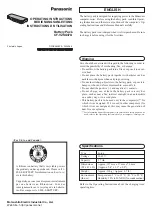
Permanent wiring to battery
I
t is possible to hard wire the DC charging leads to the battery for permanent installations.
You will need 2 ring terminals, an inline fuse holder and a fuse with a rating equal to or more than twice of the
chargers output.
5A = fuse 10A
10A = fuse 20A
15A = fuse 30A
7A = fuse 15A
12A = fuse 24A
20A = fuse 40A
Part number
Capacity
Charge time
CMF-7C12-05
30~100Ah
7~24h
CMF-7C12-07
50~140Ah
7~24h
CMF-7C12-10
70~200Ah
7~24h
CMF-7C12-12
80~250Ah
7~24h
CMF-7C12-15
100~300Ah
7~24h
CMF-7C12-20
134~400Ah
7~24h
CMF-7C24-05
35~100Ah
7~24h
CMF-7C24-10
70~200Ah
7~24h
Connection
1. Cut off the supplied battery clips; ensure you leave sufficient cable to reach the battery terminals. (DO NOT
extend the battery charger DC cables, as the added voltage drop will cause incorrect charging).
2. Fit a ring terminal to the BLACK negative (-) wire.
3. Connect the inline fuse to the RED positive (+) wire.
4. Connect a ring terminal to the other end of the inline fuse.
5. Connect the RED lead (with inline fuse and ring terminal) to the positive (+) battery pole.
6. Connect the BLACK lead (with ring terminal) to the negative (-) battery pole.
7. Fit the correctly rated fuse.
If the charger is used in a permanent / hard wired application and the vehicle will not be used for some
time .it is best to leave the charger connected to mains power (turned ‘on’) so that it can maintain the
battery fully charged.
Ensure any modification to the 220~240V AC mains lead is carried out by a qualified person and that
connection to supply mains in accordance with National wiring rules.
Charge rates
RED
BLACK



































